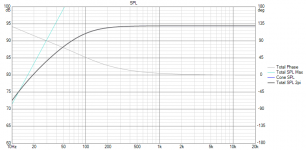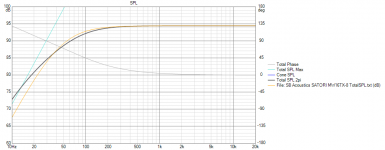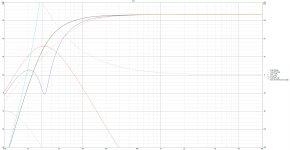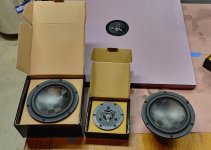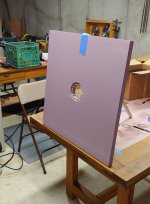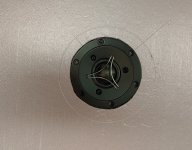The transient behaviour of my SB29 Aperiodic box is very real to me; transient perfect? Close enough. When I block the vent; the bass seems muddier or less defined; I attribute this to the Aperiodic vent doing what we are told it does; in part, reducing the larger impedance hump thus making the driver/box/vent "system" more accurately follow the input waveform. I understand it acts like a 3rd order rolloff; closed box being 2nd order and vented box being 4th order. (In my case; this works to my advantage because I have room gain in the 40 Hz region. My separate sub woofer has bass management so i can fine tune the lowest bass to help minimize room mode effects).
I'm not sure of your train of reasoning, but any system or filter that results in a significant amplitude alteration also results in a phase change. The enclosure and woofer system (sealed, or bass reflex, aperiodic, etc.) functions as a high pass filter. So the declining lower frequencies will go through significant relative phase changes, related to their low end slope order and frequency difference from the flat non-attenuated response.
Also, some incorrectly post that a system Qt =0.5 yields a transient perfect response. Qt=0.5, termed critically damped, is an engineering term related to damping and response of overshoot (or no overshoot) to a step or impulse input.
That's interresting, could you pleae tell us more about that ? The transcient perfect transcient words are often associated with this Qtc in the sealed enclosure. My basic understanding is music is made of impulse responses.
There are two plots, both are Qtc=0.5, Box volume = 70 ltr and Fb = 45Hz. The difference between the two plots is that the yellow plot is high Ql so low leakage while the gray is the APL box with low Ql meaning high leakage. The advantage is the +3dB at 20Hz. Impedance, phase and group delay is ofc also improved like they are when Transmission Line is the agenda.
Attachments
You are right... read more here: Impulse response - WikipediaThat's interresting, could you pleae tell us more about that ? The transcient perfect transcient words are often associated with this Qtc in the sealed enclosure. My basic understanding is music is made of impulse responses.
The longer a driver is ringing (unable to come to rest after the impulse) the more smeared it will sound since it cannot correctly transition to the next impulse. It becomes sluggish. That is what sealed, aperiodic and transmission line addresses. To use a non resonant resistive vent one can aid the driver by reducing the reactance of the air inside the box - the lower the reactance of the box the faster the driver can move or come to rest.
That's interresting, could you pleae tell us more about that ? The transcient perfect transcient words are often associated with this Qtc in the sealed enclosure. My basic understanding is music is made of impulse responses.
Off the cuff, I would say music is composed of impulse responses followed by ringing and its related harmonics of the musical instrument, for controlled durations. This ringing is near sinusoidal.
As far as Qtc for a sealed enclosure loudspeaker:
Q < 0.5........Over damped...........No overshoot to rest position after a step input, extended settling time, tapered low frequency response
Q = 0.5........Critically damped......No overshoot to rest position after a step input, minimum settling time without overshoot
Q > 0.5........Under damped..........Overshoot to rest position after a step input
Q = 0.577.....Bessel Function.........Very slight overshoot to rest position after a step input, minimum settling time
Q = 0.71......Butterworth Function..Slight overshoot to rest position after a step input, lowest flat frequency response
Last edited:
The point I wana make for the APL vs BR is that if you look at the image I have included you can see what each individual part does.
The BR is Bessel tuned.
The APL graph is imported onto the BR simulation - this graph is the yellow one.
The total SPL into half sphere of the BR is indicated with the dark gray graph.
The port is indicated with red - remember that a port is always 180 degree out of phase with the driver.
The cone motion is indicated in blue.
We can see that there is a complete phase shift occurring at the port tuning frequency which in this case is at 30Hz. Also notice the cone movement between 25hz to about 55Hz... In a video I found on youtube a few years ago, this dip in cone output is recorded. Both a sealed and ported enclosure is demonstrated.
Ported vs. Sealed - Detailed Comparison - YouTube
While there are some benefits seen between 20-200Hz in this case, the cone and port behavior is less than ideal in my opinion.
The BR is Bessel tuned.
The APL graph is imported onto the BR simulation - this graph is the yellow one.
The total SPL into half sphere of the BR is indicated with the dark gray graph.
The port is indicated with red - remember that a port is always 180 degree out of phase with the driver.
The cone motion is indicated in blue.
We can see that there is a complete phase shift occurring at the port tuning frequency which in this case is at 30Hz. Also notice the cone movement between 25hz to about 55Hz... In a video I found on youtube a few years ago, this dip in cone output is recorded. Both a sealed and ported enclosure is demonstrated.
Ported vs. Sealed - Detailed Comparison - YouTube
While there are some benefits seen between 20-200Hz in this case, the cone and port behavior is less than ideal in my opinion.
Attachments
...That is my underdtanding as well. So we can agree than Qtc at 0.5 is the way to go. Harmonics are in the reccording if acurate and if one has a chance to reproduce it in the right order and amplitude then better your driver to have no over or under shouting due to the load that will overlap the harmonics that follows and that are also in the next time windows? Ringing you are talking are in the reccording and not a new event created by the non good damping of the driver...theorically speaking I mean.
Can we agree here on the theory?
Can we agree here on the theory?
Last edited:
...That is my underdtanding as well. So we can agree than Qtc at 0.5 is the way to go. Harmonics are in the reccording if acurate and if one has a chance to reproduce it in the right order and amplitude then better your driver to have no over or under shouting due to the load that will overlap the harmonics that follows and that are also in the next time windows? Ringing you are talking are in the reccording and not a new event created by the non good damping of the driver...theorically speaking I mean.
Can we agree here on the theory?
Optimum perceived Qtc of a woofer system is impacted greatly by the system resonance frequency and room gain.
General Subjective Guidelines For Woofer Systems in Sealed Enclosures:
f3=100 Hz......Qtc = 0.85 to 1.1
f3= 60 Hz.......Qtc = 0.6 to 0.85
f3 = 40 hz......Qtc = 0.5 to 0.75
Relating back to Speakerbuilder or Audio-X-Press Magazine articles, optimum subjective midrange clarity was stated to be with the Qtc below 0.71, in the 0.5 to 0.65 range.
An interesting and informative article by John Kreskovs (John K) on seal enclosure woofer system Qtc and non-steady state sine wave responses. There are two pages, so use the blue & white arrow button (Top left).
About Sealed Box-Q's
Box-Q
I have been plagiarizing myself on my previous posts on this site by the above prior comments.
We are veering, and staying off track here, from the original thread "SB Acoustics Textreme".
Last edited:
Interresting link 
One doesn't want to use such good drivers without the best around... impulse response and phase... well lack of clarity and speed of the bass is not just about the damping of the cone by the material... we are on the topic here... Inverted polarity with passive filter in the tweeter can imho have great negative impact on the bass because the impulse response, just look at a good Dunlavy for instance... Without wanting to go with first slope XO, there are some other solutions to optimize the good textreme choice as already pointed out : minimum phase design à la Duelund filter or why not à la JMLC optimised filters to make the impulse response as good as possible in the crossovers area... Or digitally with Rephase for instance.. Sealed and low Qtc is not waf friendly because of the big cabinet in the bass (and also the cunterpart of a higher -f3 ... but a sympathetic -f10... well I assume electronic FIR EQ is a must to deal with the room in the low end...
I'm sure the 5" Textreme is going to give sweat to a lot of drivers ! Looking forward to read the reviews !
Anyway thanks guys for the link and sim aboce
One doesn't want to use such good drivers without the best around... impulse response and phase... well lack of clarity and speed of the bass is not just about the damping of the cone by the material... we are on the topic here... Inverted polarity with passive filter in the tweeter can imho have great negative impact on the bass because the impulse response, just look at a good Dunlavy for instance... Without wanting to go with first slope XO, there are some other solutions to optimize the good textreme choice as already pointed out : minimum phase design à la Duelund filter or why not à la JMLC optimised filters to make the impulse response as good as possible in the crossovers area... Or digitally with Rephase for instance.. Sealed and low Qtc is not waf friendly because of the big cabinet in the bass (and also the cunterpart of a higher -f3 ... but a sympathetic -f10... well I assume electronic FIR EQ is a must to deal with the room in the low end...
I'm sure the 5" Textreme is going to give sweat to a lot of drivers ! Looking forward to read the reviews !
Anyway thanks guys for the link and sim aboce
I don't understand the violation, I didn't even quote anything at all, just from memory; I didn't open the book or anything like that. If I violated a copyright; it was purely by accident; I haven't read that chapter in YEARS.
You linked to a file containing a book which is not in the public domain / for free - i.e you helped to acquire the book without paying.
//
Relating back to Speakerbuilder or Audio-X-Press Magazine articles, optimum subjective midrange clarity was stated to be with the Qtc below 0.71, in the 0.5 to 0.65 range.
The above should have read:
Relating back to Speakerbuilder or Audio-X-Press Magazine articles, for a midrange driver, optimum subjective clarity was stated to be with the Qtc below 0.71, in the 0.5 to 0.65 range.
My new drivers arrived today. A pair of TW29TXN-B and a pair of MW16TX-4.
I am fabricating a baffle to do some measurements. I am using a 24"x24" sheet of XPS foam board (thanks to XRK971 for recommending this). I hope to have some results in a couple of days... Frequency response on and off axis, harmonic distortion, etc..
I am fabricating a baffle to do some measurements. I am using a 24"x24" sheet of XPS foam board (thanks to XRK971 for recommending this). I hope to have some results in a couple of days... Frequency response on and off axis, harmonic distortion, etc..
Attachments
I have to ask... how well does the pattern of the weave line up with the mounting holes?My new drivers arrived today. A pair of TW29TXN-B and a pair of MW16TX-4.
I am fabricating a baffle to do some measurements. I am using a 24"x24" sheet of XPS foam board (thanks to XRK971 for recommending this). I hope to have some results in a couple of days... Frequency response on and off axis, harmonic distortion, etc..
I have to ask... how well does the pattern of the weave line up with the mounting holes?
Honestly I did not check that. I know it is important to some people, but it is not something I am concerned about.
Looking at the photos, it looks to me like it is aligned decently...
Attachments
- Home
- Loudspeakers
- Multi-Way
- SB Acoustics Textreme
